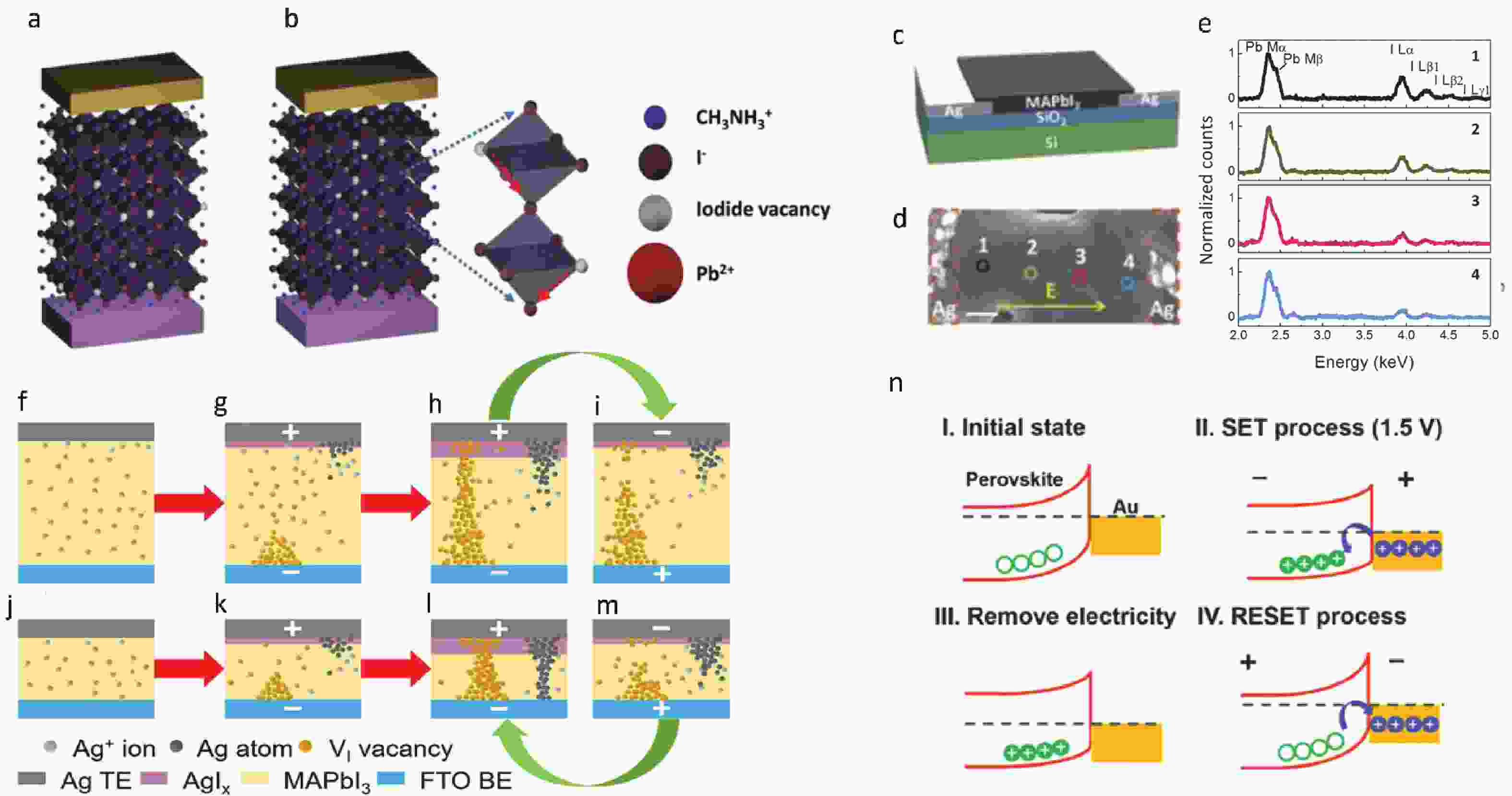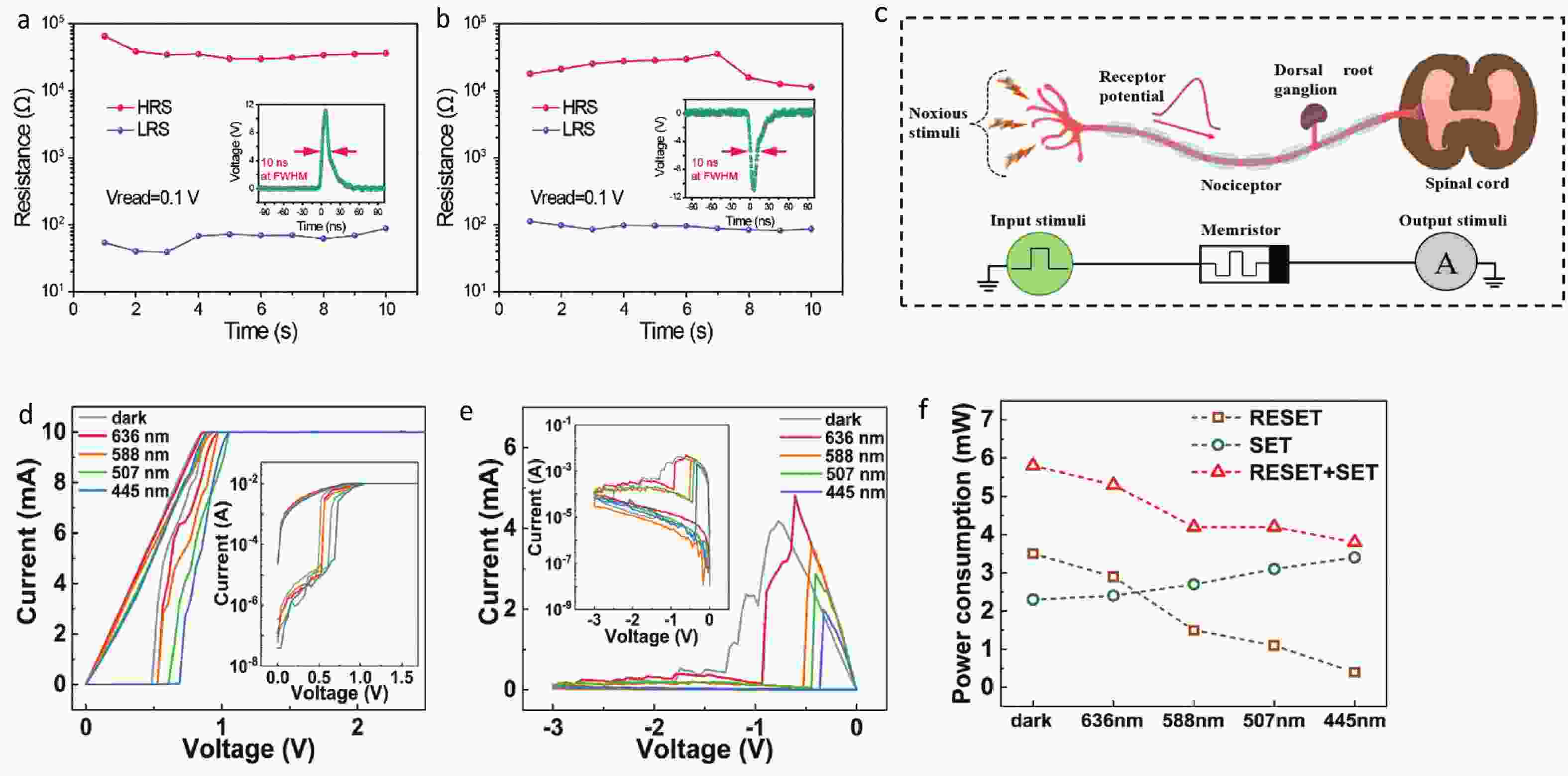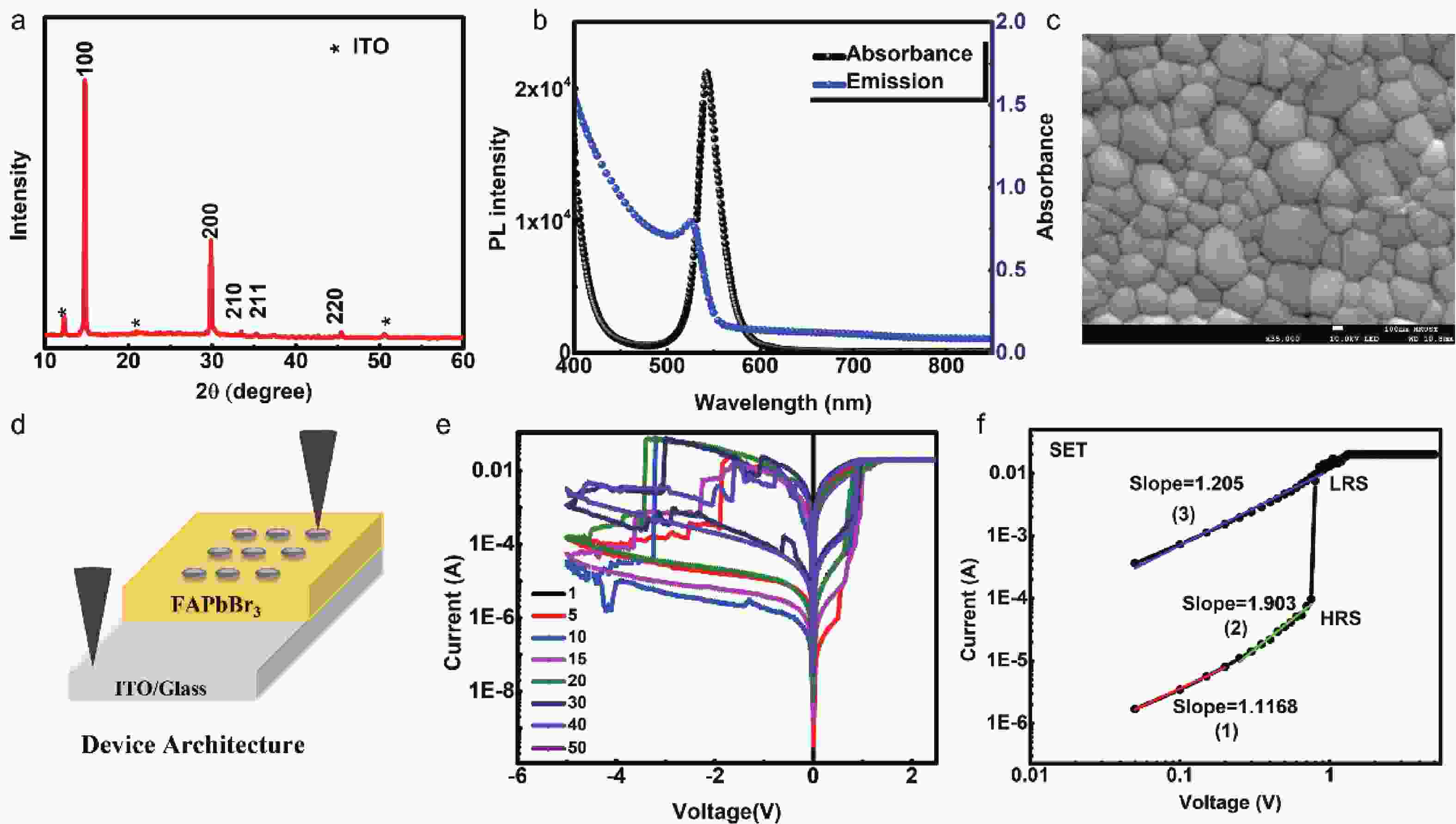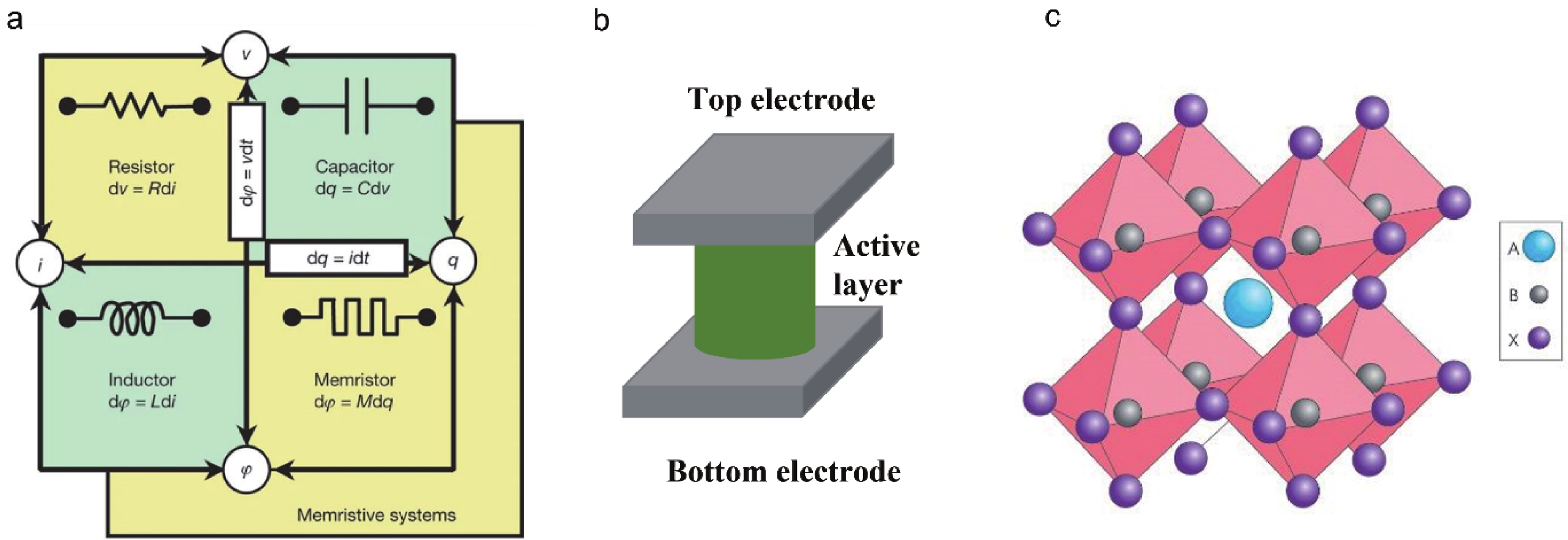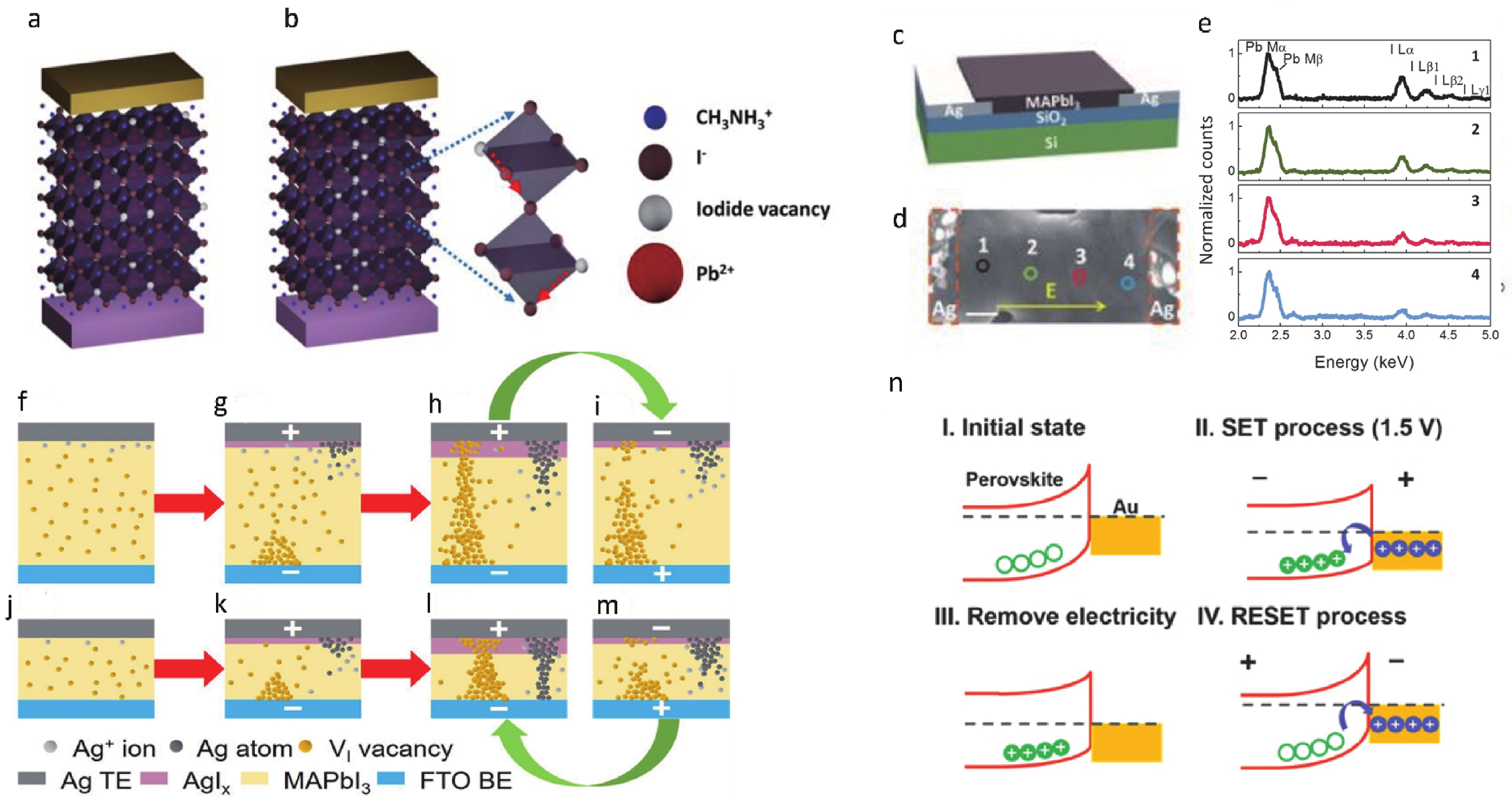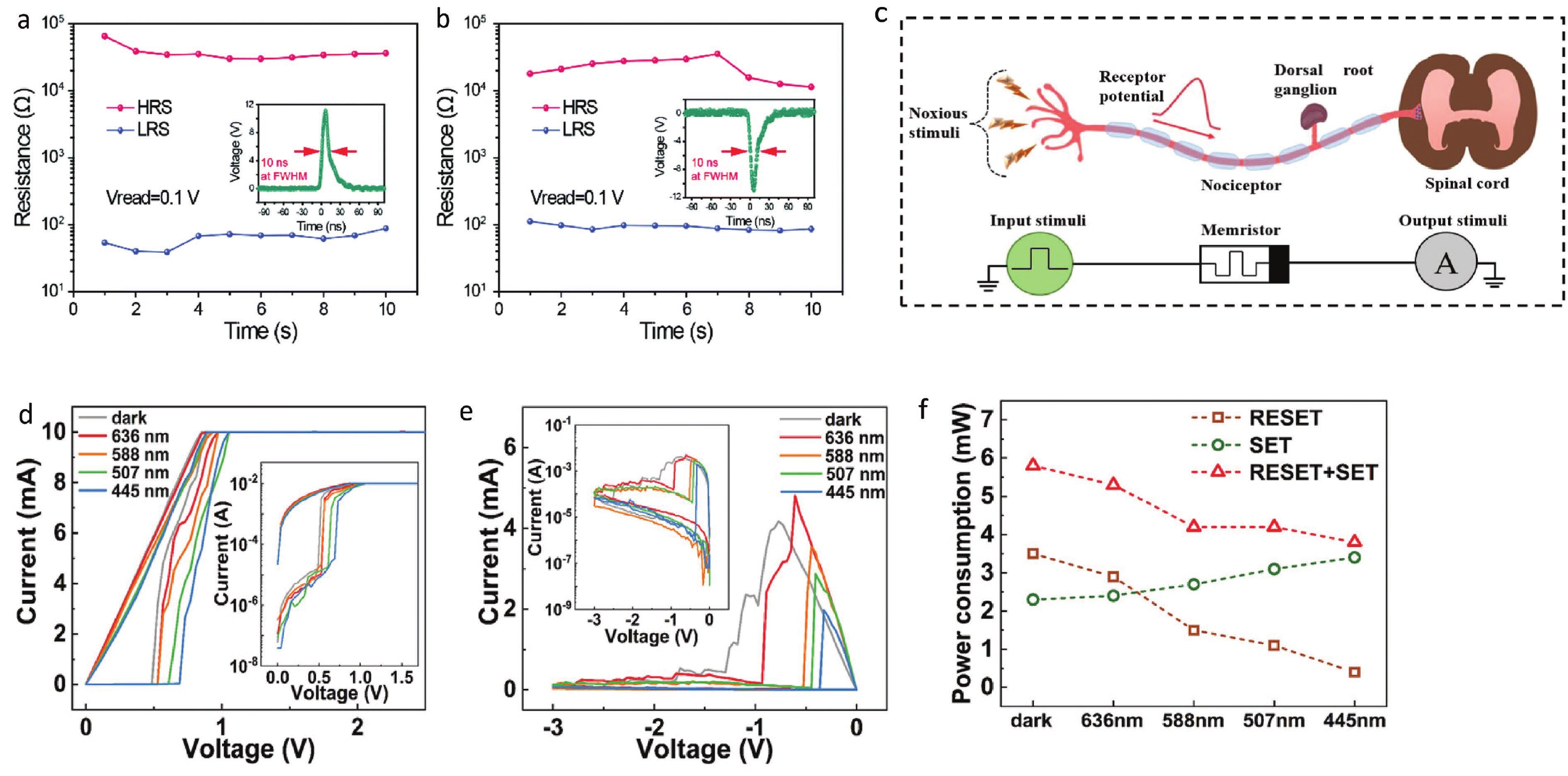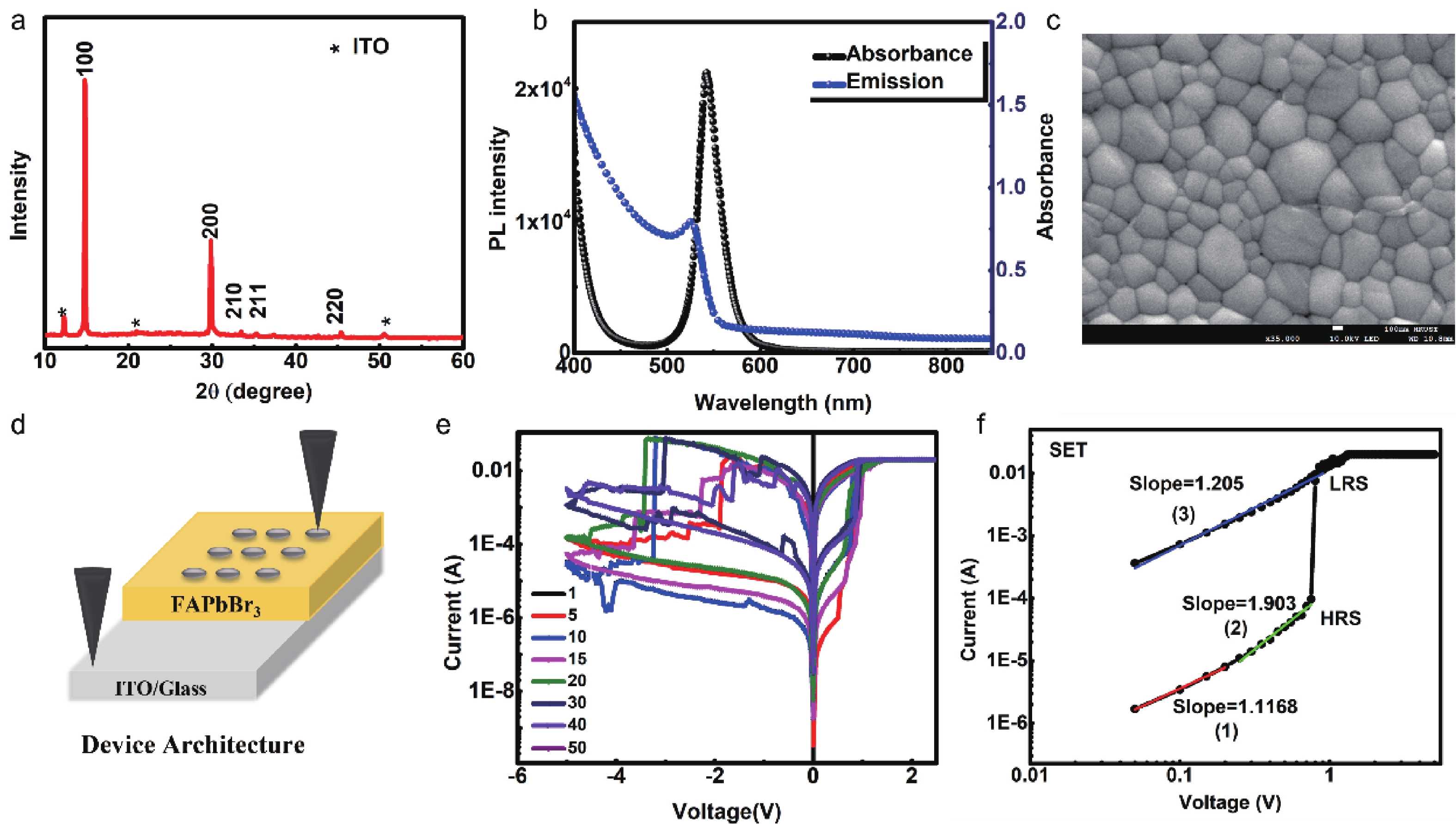| Citation: |
Memoona Qammar, Bosen Zou, Jonathan E. Halpert. Organic-inorganic halide perovskites for memristors[J]. Journal of Semiconductors, 2023, 44(9): 091604. doi: 10.1088/1674-4926/44/9/091604
M Qammar, B Zou, J E. Halpert. Organic-inorganic halide perovskites for memristors[J]. J. Semicond, 2023, 44(9): 091604. doi: 10.1088/1674-4926/44/9/091604
Export: BibTex EndNote
|
Organic-inorganic halide perovskites for memristors
doi: 10.1088/1674-4926/44/9/091604
More Information-
Abstract
Organic-inorganic halides perovskites (OHPs) have drawn the attention of many researchers owing to their astonishing and unique optoelectronic properties. They have been extensively used for photovoltaic applications, achieving higher than 26% power conversion efficiency to date. These materials have potential to be deployed for many other applications beyond photovoltaics like photodetectors, sensors, light-emitting diodes (LEDs), and resistors. To address the looming challenge of Moore's law and the Von Neumann bottleneck, many new technologies regarding the computation of architectures and storage of information are being extensively researched. Since the discovery of the memristor as a fourth component of the circuit, many materials are explored for memristive applications. Lately, researchers have advanced the exploration of OHPs for memristive applications. These materials possess promising memristive properties and various kinds of halide perovskites have been used for different applications that are not only limited to data storage but expand towards artificial synapses, and neuromorphic computing. Herein we summarize the recent advancements of OHPs for memristive applications, their unique electronic properties, fabrication of materials, and current progress in this field with some future perspectives and outlooks. -
References
[1] Chua L. Memristor-The missing circuit element. IEEE Trans Circuit Theory, 1971, 18, 507 doi: 10.1109/TCT.1971.1083337[2] Hickmott T W. Low-frequency negative resistance in thin anodic oxide films. J Appl Phys, 1962, 33, 2669 doi: 10.1063/1.1702530[3] Strukov D B, Snider G S, Stewart D R, et al. The missing memristor found. Nature, 2008, 453, 80 doi: 10.1038/nature06932[4] Chua L. Resistance switching memories are memristors. Handbook of memristor networks, 2019, 197[5] Kim S, Du C, Sheridan P, et al. Experimental demonstration of a second-order memristor and its ability to biorealistically implement synaptic plasticity. Nano Lett, 2015, 15, 2203 doi: 10.1021/acs.nanolett.5b00697[6] Chen W B, Song L K, Wang S B, et al. Essential characteristics of memristors for neuromorphic computing. Adv Elect Materials, 2023, 9, 2200833 doi: 10.1002/aelm.202200833[7] Cryer M E, Fiedler H, Halpert J E. Photo-electrosensitive memristor using oxygen doping in HgTe nanocrystal films. ACS Appl Mater Interfaces, 2018, 10, 18927 doi: 10.1021/acsami.8b05429[8] Hu Z J, Cao F, Yan T T, et al. In situ vulcanization synthesis of CuInS2 nanosheet arrays for a memristor with a high on–off ratio and low power consumption. J Mater Chem C, 2023, 11, 244 doi: 10.1039/D2TC04003D[9] Aabel P, Sai Guru Srinivasan S, Amiruddin R, et al. Bi-polar switching properties of FTO/CZTS/Ag device. J Mater Sci Mater Electron, 2023, 34, 1 doi: 10.1007/s10854-022-09392-2[10] Li Y, Zhong Y P, Xu L, et al. Ultrafast synaptic events in a chalcogenide memristor. Sci Rep, 2013, 3, 1619 doi: 10.1038/srep01619[11] Hu H R, Scholz A, Liu Y, et al. A fully inkjet-printed unipolar metal oxide memristor for nonvolatile memory in printed electronics. IEEE Trans Electron Devices, 2023, 70, 3051 doi: 10.1109/TED.2023.3269405[12] Sato K, Hayashi Y, Masaoka N, et al. High-temperature operation of gallium oxide memristors up to 600 K. Sci Rep, 2023, 13, 1 doi: 10.1038/s41598-022-26890-9[13] Basnet P, Anderson E C, Athena F F, et al. Asymmetric resistive switching of bilayer HfO x /AlO y and AlO y /HfO x memristors: The oxide layer characteristics and performance optimization for digital set and analog reset switching. ACS Appl Electron Mater, 2023, 5, 1859 doi: 10.1021/acsaelm.3c00079[14] Prezioso M, Merrikh-Bayat F, Hoskins B D, et al. Training and operation of an integrated neuromorphic network based on metal-oxide memristors. Nature, 2015, 521, 61 doi: 10.1038/nature14441[15] Wu Y H, Huang H Y, Xu C, et al. The FAPbI3 perovskite memristor with a PMMA passivation layer as an artificial synapse. Appl Phys A, 2023, 129, 1 doi: 10.1007/s00339-022-06289-z[16] Guo Z C, Xiong R, Zhu Y Y, et al. High-performance and humidity robust multilevel lead-free all-inorganic Cs3Cu2Br5 perovskite-based memristors. Appl Phys Lett, 2023, 122, 053502. doi: 10.1063/5.0129311[17] Liu Z H, Cheng P P, Kang R Y, et al. Photo-enhanced resistive switching effect in high-performance MAPbI3 memristors. Adv Materials Inter, 2023, 10, 2201513 doi: 10.1002/admi.202201513[18] Green M A, Ho-Baillie A, Snaith H J. The emergence of perovskite solar cells. Nat Photonics, 2014, 8, 506 doi: 10.1038/nphoton.2014.134[19] Bati A S R, Zhong Y L, Burn P L, et al. Next-generation applications for integrated perovskite solar cells. Commun Mater, 2023, 4, 1 doi: 10.1038/s43246-022-00329-0[20] DeQuilettes D W, Zhang W, Burlakov V M, et al. Photo-induced halide redistribution in organic–inorganic perovskite films. Nat Commun, 2016, 7, 1 doi: 10.1038/ncomms11683[21] Xiao Z G, Yuan Y B, Shao Y C, et al. Giant switchable photovoltaic effect in organometal trihalide perovskite devices. Nat Mater, 2015, 14, 193 doi: 10.1038/nmat4150[22] Zhang C, Li Y, Ma C L, et al. Recent progress of organic–inorganic hybrid perovskites in RRAM, artificial synapse, and logic operation. Small Sci, 2022, 2, 2100086 doi: 10.1002/smsc.202100086[23] Gu C, Lee J S. Flexible hybrid organic–inorganic perovskite memory. ACS Nano, 2016, 10, 5413 doi: 10.1021/acsnano.6b01643[24] Zhu X J, Lee J H, Lu W D. Perovskite films: Iodine vacancy redistribution in organic-inorganic halide perovskite films and resistive switching effects. Adv Mater, 2017, 29, 1700527 doi: 10.1002/adma.201700527[25] Kim D J, Tak Y J, Kim W G, et al. Resistive switching properties through iodine migrations of a hybrid perovskite insulating layer. Adv Mater Interfaces, 2017, 4, 1601035 doi: 10.1002/admi.201601035[26] Yan K, Peng M, Yu X, et al. High-performance perovskite memristor based on methyl ammonium lead halides. J Mater Chem C, 2016, 4, 1375 doi: 10.1039/C6TC00141F[27] Yoo E, Lyu M Q, Yun J H, et al. Bifunctional resistive switching behavior in an organolead halide perovskite based Ag/CH3NH3PbI3− x Cl x /FTO structure. J Mater Chem C, 2016, 4, 7824 doi: 10.1039/C6TC02503J[28] Wang W, Xu J Q, Ma H L, et al. Insertion of nanoscale AgInSbTe layer between the Ag electrode and the CH3NH3PbI3 electrolyte layer enabling enhanced multilevel memory. ACS Appl Nano Mater, 2019, 2, 307 doi: 10.1021/acsanm.8b01928[29] Sun Y M, Tai M Q, Song C, et al. Competition between metallic and vacancy defect conductive filaments in a CH3NH3PbI3-based memory device. J Phys Chem C, 2018, 122, 6431 doi: 10.1021/acs.jpcc.7b12817[30] Zhou F C, Liu Y H, Shen X P, et al. Low-voltage, optoelectronic CH3NH3PbI3– x Cl x memory with integrated sensing and logic operations. Adv Funct Mater, 2018, 28, 1800080 doi: 10.1002/adfm.201800080[31] Yoo E J, Lyu M Q, Yun J H, et al. Resistive switching behavior in organic-inorganic hybrid CH3NH3PbI3 –x Cl x Perovskite for resistive random access memory devices. Adv Mater, 2015, 27, 6170 doi: 10.1002/adma.201502889[32] Cai H M, Ma G K, He Y L, et al. A remarkable performance of CH3NH3PbI3 perovskite memory based on passivated method. Org Electron, 2018, 58, 301 doi: 10.1016/j.orgel.2018.04.025[33] Gogoi H J, Mallajosyula A T. Enhancing the switching performance of CH3NH3PbI3 memristors by the control of size and characterization parameters. Adv Elect Materials, 2021, 7, 2100472 doi: 10.1002/aelm.202100472[34] Qian W H, Cheng X F, Zhou J, et al. Lead-free perovskite MASnBr3-based memristor for quaternary information storage. InfoMat, 2020, 2, 743 doi: 10.1002/inf2.12066[35] Xiao Z G, Huang J S. Energy-efficient hybrid perovskite memristors and synaptic devices. Adv Electron Mater, 2016, 2, 1600100 doi: 10.1002/aelm.201600100[36] Poddar S, Zhang Y T, Zhu Y Y, et al. Optically tunable ultra-fast resistive switching in lead-free methyl-ammonium bismuth iodide perovskite films. Nanoscale, 2021, 13, 6184 doi: 10.1039/D0NR09234G[37] Seo J Y, Choi J, Kim H S, et al. Wafer-scale reliable switching memory based on 2-dimensional layered organic–inorganic halide perovskite. Nanoscale, 2017, 9, 15278 doi: 10.1039/C7NR05582J[38] Tian H, Zhao L F, Wang X F, et al. Extremely low operating current resistive memory based on exfoliated 2D perovskite single crystals for neuromorphic computing. ACS Nano, 2017, 11, 12247 doi: 10.1021/acsnano.7b05726[39] Lee D, Hwang B, Lee J S. Impact of grain sizes on programmable memory characteristics in two-dimensional organic–inorganic hybrid perovskite memory. ACS Appl Mater Interfaces, 2019, 11, 20225 doi: 10.1021/acsami.9b05038[40] Kim H, Choi M J, Suh J M, et al. Quasi-2D halide perovskites for resistive switching devices with ON/OFF ratios above 109. NPG Asia Mater, 2020, 12, 21 doi: 10.1038/s41427-019-0187-x[41] Muthu C, Agarwal S, Vijayan A, et al. Hybrid perovskite nanoparticles for high-performance resistive random access memory devices: Control of operational parameters through chloride doping. Adv Mater Interfaces, 2016, 3, 1600092 doi: 10.1002/admi.201600092[42] Yang K Y, Li F S, Veeramalai C P, et al. A facile synthesis of CH3NH3PbBr3 perovskite quantum dots and their application in flexible nonvolatile memory. Appl Phys Lett, 2017, 110, 083102 doi: 10.1063/1.4976709[43] Hwang B, Lee J S. A strategy to design high-density nanoscale devices utilizing vapor deposition of metal halide perovskite materials. Adv Mater, 2017, 29, 1701048 doi: 10.1002/adma.201701048[44] Hwang B, Gu C, Lee D, et al. Effect of halide-mixing on the switching behaviors of organic-inorganic hybrid perovskite memory. Sci Rep, 2017, 7, 43794 doi: 10.1038/s41598-016-0028-x[45] Zhang X H, Zhao X N, Shan X Y, et al. Humidity effect on resistive switching characteristics of the CH3NH3PbI3 memristor. ACS Appl Mater Interfaces, 2021, 13, 28555 doi: 10.1021/acsami.1c05590[46] Cheng X F, Qian W H, Wang J, et al. Environmentally robust memristor enabled by lead-free double perovskite for high-performance information storage. Small, 2019, 15, 1905731 doi: 10.1002/smll.201905731[47] John R A, Yantara N, Ng Y F, et al. Ionotronic halide perovskite drift-diffusive synapses for low-power neuromorphic computation. Adv Mater, 2018, 30, 1805454 doi: 10.1002/adma.201805454[48] Shivarudraiah S B, Tewari N, Ng M, et al. Optically clear films of formamidinium lead bromide perovskite for wide-band-gap, solution-processed, semitransparent solar cells. ACS Appl Mater Interfaces, 2021, 13, 37223 doi: 10.1021/acsami.1c10657[49] Patil H, Kim H, Kadam K D, et al. Flexible organic–inorganic halide perovskite-based diffusive memristor for artificial nociceptors. ACS Appl Mater Interfaces, 2023, 15, 13238 doi: 10.1021/acsami.2c16481[50] Poddar S, Zhang Y T, Gu L L, et al. Down-scalable and ultra-fast memristors with ultra-high density three-dimensional arrays of perovskite quantum wires. Nano Lett, 2021, 21, 5036 doi: 10.1021/acs.nanolett.1c00834[51] Guan X W, Wan T, Hu L, et al. A solution-processed all-perovskite memory with dual-band light response and tri-mode operation. Adv Funct Materials, 2022, 32, 2110975 doi: 10.1002/adfm.202110975[52] Kulbak M, Gupta S, Kedem N, et al. Cesium enhances long-term stability of lead bromide perovskite-based solar cells. J Phys Chem Lett, 2016, 7, 167 doi: 10.1021/acs.jpclett.5b02597[53] Le Q V, Lee J W, Sohn W, et al. Low temperature solution-processable cesium lead bromide microcrystals for light conversion. Cryst Growth Des, 2018, 18, 3161 doi: 10.1021/acs.cgd.8b00264[54] Guan X W, Lei Z H, Yu X C, et al. Low-dimensional metal-halide perovskites as high-performance materials for memory applications. Small, 2022, 18, 2203311 doi: 10.1002/smll.202203311[55] Hu L, Zhao Q, Huang S J, et al. Flexible and efficient perovskite quantum dot solar cells via hybrid interfacial architecture. Nat Commun, 2021, 12, 466 doi: 10.1038/s41467-020-20314-w[56] Yin J, Maity P, Naphade R, et al. Tuning hot carrier cooling dynamics by dielectric confinement in two-dimensional hybrid perovskite crystals. ACS Nano, 2019, 13, 12621 doi: 10.1021/acsnano.9b04085[57] Kim J, Hu L, Chen H J, et al. P-type charge transport and selective gas sensing of all-inorganic perovskite nanocrystals. ACS Mater Lett, 2020, 2, 1368 doi: 10.1021/acsmaterialslett.0c00346[58] Cheng X F, Hou X, Zhou J, et al. Pseudohalide-induced 2D (CH3NH3)2PbI2(SCN)2 perovskite for ternary resistive memory with high performance. Small, 2018, 14, 1703667 doi: 10.1002/smll.201703667[59] Zhao J, Li S J, Tong W C, et al. Light-induced anomalous resistive switches based on individual organic-inorganic halide perovskite micro-/ nanofibers. Adv Electron Mater, 2018, 4, 1800206 doi: 10.1002/aelm.201800206[60] Jiang T H, Shao Z B, Fang H, et al. High-performance nanofloating gate memory based on lead halide perovskite nanocrystals. ACS Appl Mater Interfaces, 2019, 11, 24367 doi: 10.1021/acsami.9b03474[61] Yang J Q, Wang R P, Wang Z P, et al. Leaky integrate-and-fire neurons based on perovskite memristor for spiking neural networks. Nano Energy, 2020, 74, 104828 doi: 10.1016/j.nanoen.2020.104828[62] Zhang Y T, Poddar S, Huang H, et al. Three-dimensional perovskite nanowire array–based ultrafast resistive RAM with ultralong data retention. Sci Adv, 2021, 7, eabg3788 doi: 10.1126/sciadv.abg3788 -
Proportional views





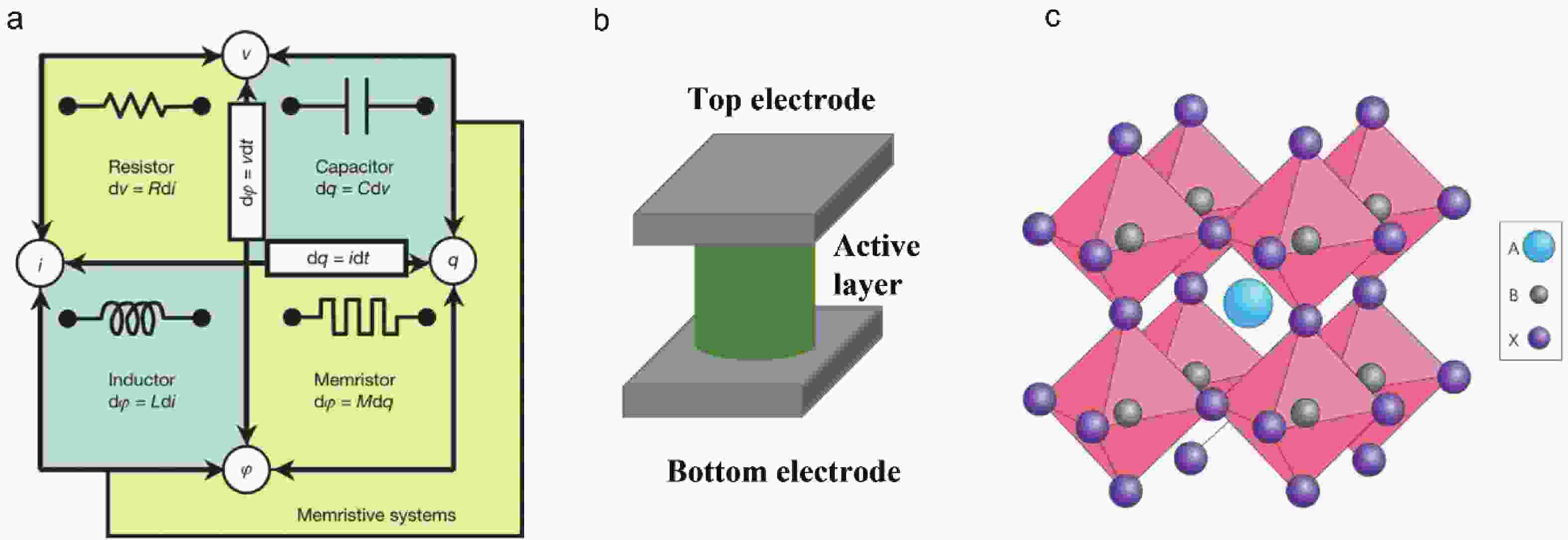
 DownLoad:
DownLoad:
